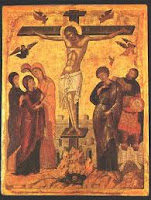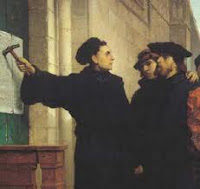
Verse 1
And can it be that I should gainAn interest in the Saviour's blood?Died He for me, who caused His pain-For me, who Him to death pursued?Amazing love! How can it be,That Thou, my God, shouldst die for me?So begins one of the theologically richest hymns ever written. Written by Charles Wesley, many say that if Methodism were to have a
fight song this would unquestionably be it.
Thanks to
Jonathan Powers' direction, I was taken to
this article, which is a snippet about some of the background of Charles' writing the hymn. For instance, the hymn was first published under the title 'Free Grace,' which is interesting given that one of John Wesley's most famous sermons shares the
same title (another reason to make this the
fight song of Methodism). The lyrics, the author of the article notes, relates closely to Charles' special experience on May 21, 1738 (three days before his brother John's experience at Aldersgate where his heart was "strangely warmed"). Although rules of grammar are suspended to a certain degree when it comes to poetry, I am struck that this hymn begins with a coordinating conjunction: "
And can it be...". I wondered if this meant that Charles originally had this hymn as a follow-up to a previous hymn or if it had some sort of poetical or theological significance. With no evidence that I've seen to the former, the latter seems most probable. Since Jonathan (mentioned above) is more of an expert on Charles and on hymnody in general, I asked him. He responded with this insightful thought:
"By using 'And'+ it marks the song as a response/reflection on conversion." This strengthens the case that this hymn is deeply connected to the experience referenced above, an experience (similar to John's) that many call Charles' conversion.
The hymn begins with a coordinating conjunction because this hymn marks the response of someone who is in awe of the extent of God's love.
Or, as the author of the article above put it, "The questions that open the hymn are a remarkable reiteration of the perplexion faced by one who is confronted by the wonder of God’s forgiving love...This mystery is at the heart of God’s love and mercy, which is inexplicable even to the angels. We are left simply to adore the depths of divine mercy." This is that upon which this hymn is grounded. This is that upon which our salvation is founded:
God's infinite, perplexing, and forgiving love! In Charles' journal on 14 August 1741, he records this:
I went after a stray sheep, who was turned out of the way by the predestinarians; but the good Shepherd had found her himself, and brought her home rejoicing. For some days she had been under the full influence of that narrow opinion, and could not bear any of her brethren and sisters. Then she cried unto the Lord to show her the truth, and he answered her by his own mouth. The true light broke in upon her, and in his light she saw that God is love. She is now humbled in the dust before him, for having "robbed him of his most darling attribute."
Notice that he says it is
love that is God's "darling attribute." We'll see the theme of 'light breaking in' in another verse, so stay tuned for that. Interestingly, the topic of John's sermon 'Free Grace,' Charles' journal entry above, and John's treatise 'Predestination Calmly Considered' all center on the controverted issue of predestination and the Wesleys' disagreement with the Calvinists' take of the issue. But in all of these (and more), it is
'love' that is at the heart of God's nature and hence God's intent in saving fallen humanity. John, in 'Predestination Calmly Considered':
So ill do election and reprobation agree with the truth and sincerity of God! But do they not agree least of all with the scriptural account of his love and goodness? that attribute which God peculiarly claims, wherein he glories above all the rest. It is not written, “God is justice,” or “God is truth” (although he is just and true in all his ways). But it is written, “God is love,” love in the abstract, without bounds; and "there is no end of his goodness."
Two final points that probably deserve much more consideration. First, the lyrics
'gain an interest in the Saviour's blood' convey the metaphor of sin as debt and atonement as redemption (or perhaps ransom) with the language of commerce in
gaining interest. This should not be read to suggest that 'ransom' or commercial atonement theology governs the Wesleys' (or at least Charles') approach to the atonement. Indeed, this hymn will go on to portray other themes that lay at the heart of Jesus' atoning death, but it does show that there is something immeasurable we gain in the death of Jesus. I think this is conveyed somewhat in 'How Deep the Father's Love for Us' by Stuart Townend in the lyrics:
Why should I gain from his reward?
I cannot give an answer.
But this I know with all my heart:
His death has paid my ransom.
Second (and finally), in relation to the recent posts about
Tertullian's and
Cyril of Alexandria's takes on the Godhead at the cross (you'll want to read the couple of comments on each post) comes the question of the final part of this verse: what did Charles import into
"That Thou, my God, shouldst die for me?" Jonathan raised this question in the comments on the post about Tertullian. Though I could be mistaken as to Charles' meaning, I don't think he was making a theological argument to suggest that Christ's divinity died at the cross. If he was doing that, then I think he stood in opposition to the conclusions of the early church (most notably Cyril's theology, affirmed in the Council of Chalcedon). I rather think that Charles was using 'my God' as an expression much like Thomas cried in John 20.28. Charles rightly recognizes that Jesus is indeed
"My Lord and my God!" It is an exclamation that, returning to an earlier point, shows our wonder at the
infinite and perplexing breadth and depth of God's love, God's 'free grace'!























